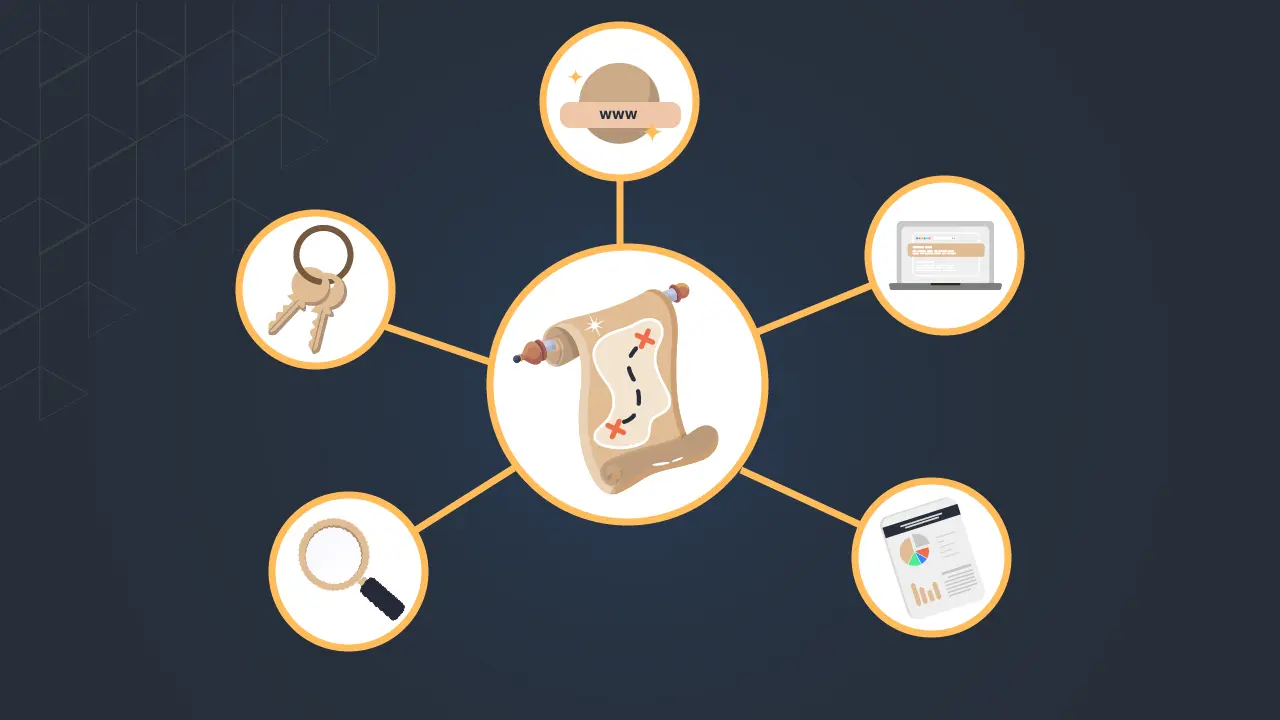Having many keywords targeting different products or services on a website might be challenging to manage. Thus, SEO specialists and professional content writers must find a way to manage all of them so they are distinct in terms of content.
By mapping keywords to specific pages, sections, and elements of a website, businesses can improve their website's relevance, search engine rankings, and overall visibility.
This article provides actionable insights and guidance on conducting keyword research, mapping keywords to website structure, creating optimized content, and tracking keyword performance. Here's how
What is Keyword Mapping?
Keyword mapping refers to the strategic process of aligning relevant keywords with specific pages or sections of a website. It involves identifying the most appropriate keywords that align with the content and purpose of each web page.
Then, optimize the page by integrating those keywords in various elements such as headings, titles, meta tags, and the content itself. The goal is to establish a strong connection between the keywords and the content, signaling to search engines the relevance and intent of the page.
Implementing effective keyword mapping can yield several benefits in SEO campaigns:
Improved search engine rankings: Keyword mapping helps search engines understand the context and relevance of web pages.
Enhanced user experience and navigation: Well-structured keyword mapping leads to organized and user-friendly websites. Visitors can easily navigate through the site, finding relevant content that matches their search intent.
Targeted traffic generation:It also ensures that the right audience finds your website. By mapping keywords specific to your target market, you can attract highly relevant traffic that is more likely to convert

Picture 1: Keyword Mapping Illustration
Key Components of Keyword Mapping
To achieve successful keyword mapping, it's important to consider the following key components:
Thorough keyword research: Conduct comprehensive keyword research to identify relevant and high-performing keywords. Use tools and techniques to determine search volume, competition, and user intent associated with each keyword.
Relevance and alignment: Ensure that the keywords you select accurately represent the content and purpose of each page. Align the keywords with the topics, themes, and intent of the page to provide a seamless user experience.
Strategic placement: Place the mapped keywords strategically throughout the page, including in titles, headings, meta tags, URLs, and content. However, it's crucial to maintain a natural and organic flow of language to avoid keyword stuffing, which can negatively impact SEO.
Regular monitoring and adjustment: Continuously monitor the performance of your mapped keywords using analytics tools. Analyze the rankings, traffic, and engagement metrics to make data-driven adjustments and optimize your strategy over time.
Steps to Effective Keyword Mapping Strategy
After understanding what is keyword mapping, its component, and why it is matter, here we present the steps you can take to create a great mapping strategy.
1. Thorough Keyword Research
Keyword research forms the foundation of successful SEO keyword mapping. By conducting thorough research, you can identify the most relevant and high-ranking keywords for your website. Here are the steps involved:
Utilizing keyword research tools: Utilize keyword research tools such as Google Keyword Planner, or Free Keyword Research Tool to generate a list of potential keywords related to your industry or niche.
Identifying relevant and high-ranking keywords: Analyze the generated list and identify keywords that are relevant to your website's content and align with your target audience's search intent. Focus on keywords that have a good balance between search volume and competition.
Analyzing keyword competition and search volume: Assess the competition level and search volume associated with each keyword. Look for keywords with a moderate level of competition and a decent search volume to ensure a reasonable chance of ranking.
We have a thorough discussion about how to analyze keywords after you fetch them from your favorite tool. You can try using this free tool to make sure you have the most worthy keywords.

Picture 2: Free Keyword Research Tool from Sequence Stats
2. Organizing Keywords into Groups
Once you have a list of relevant keywords, it's essential to organize them into groups based on their relevance and intent. This step helps you create a structured mapping plan. Follow these steps:
Categorizing keywords based on relevance and intent: Group similar keywords that share common themes or intent. For example, if you have an e-commerce website selling shoes, you might have groups like "running shoes," "athletic shoes," or "casual shoes."
Grouping keywords by website sections or pages: Assign each keyword group to specific sections or pages of your website. Ensure that each group aligns with the content and purpose of the corresponding page. This helps search engines understand the relevance of each page and its connection to specific keywords.
Ensuring a balanced distribution of keywords: Distribute the keywords evenly across your website to maintain a natural keyword density. Avoid overloading a single page with too many keywords, as it can negatively affect the user experience and search engine rankings.
3. Mapping Keywords to Website Structure
Mapping keywords to your website's structure involves strategically assigning keywords to various elements of your website. Here are the steps you can take:
Analyzing website hierarchy and architecture: Evaluate your website's hierarchy and navigation structure. Understand how different pages and sections are organized and interconnected. This analysis helps you identify the most suitable places to integrate your keywords.
Assigning keywords to the website section: Optimize your URLs, page titles, headings (H1, H2, etc.), and meta tags by incorporating relevant keywords. This helps search engines understand the content and context of each page, boosting its visibility in search results.
Incorporating keywords naturally and strategically: While it's important to include keywords in the above-mentioned elements, ensure they are incorporated naturally and seamlessly into the content. Avoid keyword stuffing, which can harm your SEO efforts. Focus on providing valuable and relevant content that satisfies user search intent.
4. Creating Optimized Content
Optimizing your content with mapped keywords is crucial for effective keyword mapping. Follow these steps to create optimized content:
Aligning content with mapped keywords: Develop content that aligns with the mapped keywords for each page. Ensure that the keywords are seamlessly integrated into the content, making it relevant and valuable to users.
Crafting compelling and relevant content for target keywords: Write engaging and informative content that satisfies user search intent. Provide answers, solutions, or valuable insights related to the keywords users are searching for.
Optimizing on-page elements for keywords: Optimize on-page elements such as headings, subheadings, image alt tags, and internal links to include relevant keywords. This further strengthens the connection between the keywords and the content, signaling their importance to search engines.
By following these steps, you can effectively map keywords to your website's structure and content.
Tracking and Monitoring Keyword Performance
The keyword mapping strategy doesn’t stop there, once you applied the mapping strategy, you need to track and monitor the keyword performance. Utilize Keyword Ranking Tracker to monitor the performance of your keywords. These tools provide insights into the following:
Keyword rankings: Monitor the positions of your mapped keywords in search engine results pages (SERPs) daily. Track their progress and identify any fluctuations or changes in rankings.
Search visibility: Assess the overall visibility of your website by examining the search visibility metrics associated with your keywords. This gives you an indication of how well your website is performing in the search results.
Based on the insights gained from tracking and analyzing keyword performance, it's important to make data-driven adjustments to your keyword mapping strategy. Consider the following steps:
Identify underperforming keywords: Identify keywords that are not delivering the desired results in terms of rankings, traffic, or engagement. These keywords may need further optimization or replacement with more effective alternatives.
Refine keyword selection: Analyze keyword research data to identify new keywords that align better with your content and target audience's search intent. Incorporate these keywords into your mapping strategy to improve performance.
Optimize content and on-page elements: If certain pages or sections are not performing well, consider optimizing the content and on-page elements. This may involve updating the content to better align with the mapped keywords, improving headings and meta tags, or enhancing the overall user experience.
Monitor and iterate: Continuously monitor the impact of your adjustments and iterations on keyword performance. Make changes and track their effects to fine-tune your keyword mapping strategy over time.

Picture 3: Keyword Rank Tracker in the Sequence Stats that reports daily keyword ranking
Wrap-Up
Keyword mapping is an essential strategy for achieving SEO success and improving online visibility. By following the steps outlined in this article, you can effectively map keywords to your website's structure and create optimized content that aligns with user search intent.
Embrace this strategy as the ultimate strategy for long-term SEO success and unlock the full potential of your online presence. Start mapping your keywords strategically today and experience the benefits of a well-optimized website.
Use Sequence Stats to help you do SEO better!